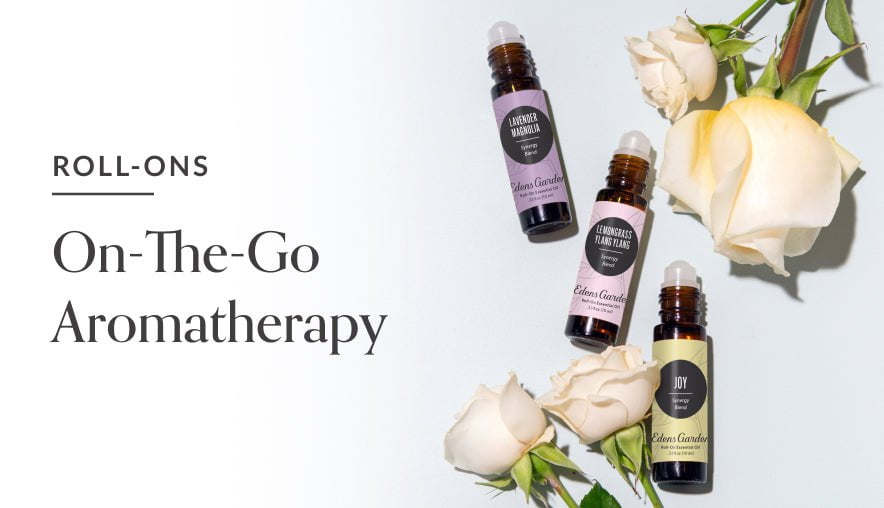10 Essential Oils You've Never Used (And How to Use Them)

This content was updated for accuracy and relevance on May 6th, 2022
With so many choices in the world, most people stick with what they know rather than explore new options. Essential oil users are no different, which is why we’ve curated a list of the best essential oils you probably haven’t tried along with our favorite ways to use them. At Edens Garden, we hope trying new oils is the beginning of a deeper, more satisfying aromatherapy experience. Read on to discover our 10 top underrated oils.
10 Essential Oils You've Never Used And How to Use Them
Can you say you’ve tried these ten oils?
#1 Cajeput
A relative of Tea Tree oil, Cajeput oil has many similar characteristics to Tea Tree and Eucalyptus oil. Its aroma is bright, medicinal and camphorous. This oil offers respiratory support and relief to sore muscles.
How to Use: Add 60 drops Cajeput, 20 drops Peppermint oil, 15 drops Clove oil and 5 drops Cinnamon oil[1] to a 5 ml bottle for two-in-one muscle relief and immune boosting blend. To use topically, combine 2 tbsp of carrier oil and 18 drops of your blend. For sensitive skin, use 9 drops.
#2 Celery Seed
A popular pick in the produce aisle but not in aromatherapy, Celery Seed has a unique spicy, root-like aroma. Celery Seed oil is commonly used for digestive and circulatory issues. Its immense amount of naturally occurring limonene also makes it a great immune booster.
How to Use: Combine 8 drops Celery Seed, 4 drops Geranium oil, 3 drops Rosemary oil and 3 drops Lemon oil with 2 tbsp of Sweet Almond carrier oil to improve circulation.
#3 Cistus
Cistus oil is emotionally grounding and often inhaled during prayer and meditation. In perfumery, it’s used as a fixative for its deep-balsamic, peppery aroma. Cistus is effectively applied in skincare for its ability to reverse the look of mature skin.
How to Use: Mix 3 drops Cistus, 2 drops Sandalwood oil and 1 drop Geranium- Rose in 2 tbsp of Prickly Pear Seed carrier oil. Apply to the face as the last step in your skincare routine both morning and night.
#4 Cognac
Like the liquor, Cognac oil has a wonderfully fruity, spicy, aged aroma and makes a great addition to natural soaps and candles. Cognac essential oil is naturally sedative and analgesic because it’s made up of mostly esters.
How to Use: Blend together 5 drops Cognac, 5 drops Amyris oil, 3 drops Vanilla oil and 2 drops Cinnamon essential oil in 2 tbsp of Fractionated Coconut carrier oil for a musky, woody cologne. Transfer to a small spray bottle.
#5 Davana
Known for its ability to change aromas when used topically on different people, Davana has a sweet, watermelon-like aroma. Davana oil may offer symptom relief during PMS and menopause, making it a helpful aid to women’s wellness.
How to Use: Add 2 drops of Davana to a roll-on bottle and top off with Fenugreek carrier oil. Apply to pulse points, abdomen and back for PMS and menopausal discomfort.
#6 Elemi
A native of the Philippines, Elemi is a relative of Frankincense oil and Myrrh oil. Its resin is steam distilled to create the deep, citrusy, piney oil we know and love. This oil has the ability to nourish skin, aid in respiratory health and alleviate feelings of pain.
How to Use: Put 1 drop Elemi oil and 1 drop Ravintsara oil in a large bowl of hot water. Close your eyes, place your face over the bowl and cover your head with a towel. Inhale the steam for five minutes to open air passageways and clear congestion.
#7 Galbanum
Used in ancient Egypt and by early physicians such as Hippocrates, Galbanum oil has sustained time as a unique healing oil. Its aroma is known for being extremely herbaceous and green. Galbanum is commonly used for skin healing and nourishment.
How to Use: Combine 1 drop of Galbanum and 1 drop of Clary Sage with 2 tsp Rosehip carrier oil. Apply to face, neck and the back of hands to firm and tighten skin.
#8 Goldenrod
Goldenrod was a staple in early Native American medicine. Its aroma is grassy, and earthy and adds a fresh, green note to perfumes. Goldenrod oil is multifaceted, offering allergy relief, antiseptic properties and arthritis support.
How to Use: Add 5 drops Goldenrod, 3 drops Chamomile- Roman and 2 drops Lemon essential oil to an essential oil inhaler for allergy relief. Alternatively, add this blend to your diffuser.
#9 Ledum
Also known as Labrador Tea, Ledum oil is distilled from a flowering herb. With a peppery aroma, Ledum has uses in rejuvenating massage blends and may be an effective decongestant.
How to Use: Add to a 2 oz squeeze bottle 6 drops Ledum, 4 drops Orange oil,[2] 3 drops Tea Tree, 3 drops Lavender- French oil and 5 drops Niaouli oil, then fill with Jojoba carrier oil and shake to mix well. Apply to the skin after bath or for full body massage.
#10 Opoponax
A relative of Frankincense and Myrrh,[3] Opoponax is extracted from the resin of the Opoponax tree. Its aroma is balsamic, musky and likened to Frankincense. Opoponax oil is known for its skin healing, decongestant and anti-inflammatory properties.
How to Use: Mix 32 drops Opoponax, 15 drops Frankincense, 15 drops Myrrh and 10 drops Lavender essential oil in 4 oz of Unscented Body Oil for a grounding, skin-healing moisturizer.
SOURCES:
- Cinnamon Oil Benefits, Uses, Side Effects, & Interactions https://www.healthline.com/health/cinnamon-oil
- Orange Essential Oil Uses, Benefits, and Safety. https://www.healthline.com/health/orange-essential-oil-uses
- Health Benefits of Frankincense Essential Oil. https://www.webmd.com/diet/health-benefits-frankincense-essential-oil










Leave a comment (Comments will be approved before showing up)